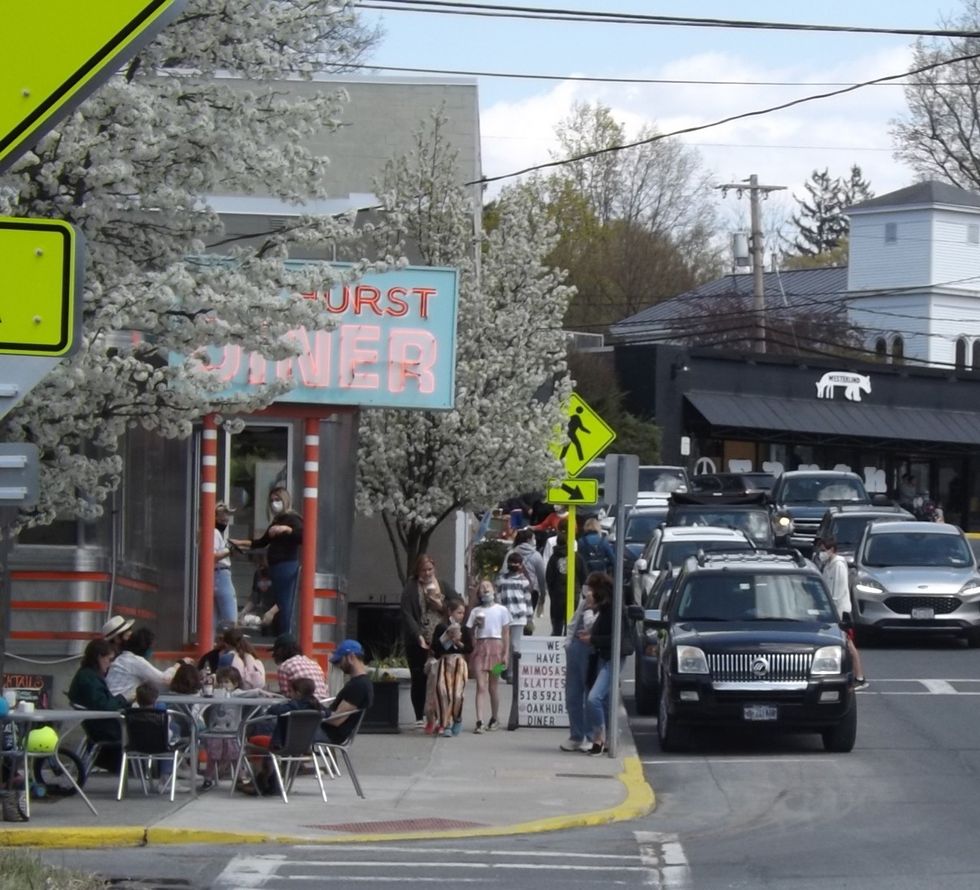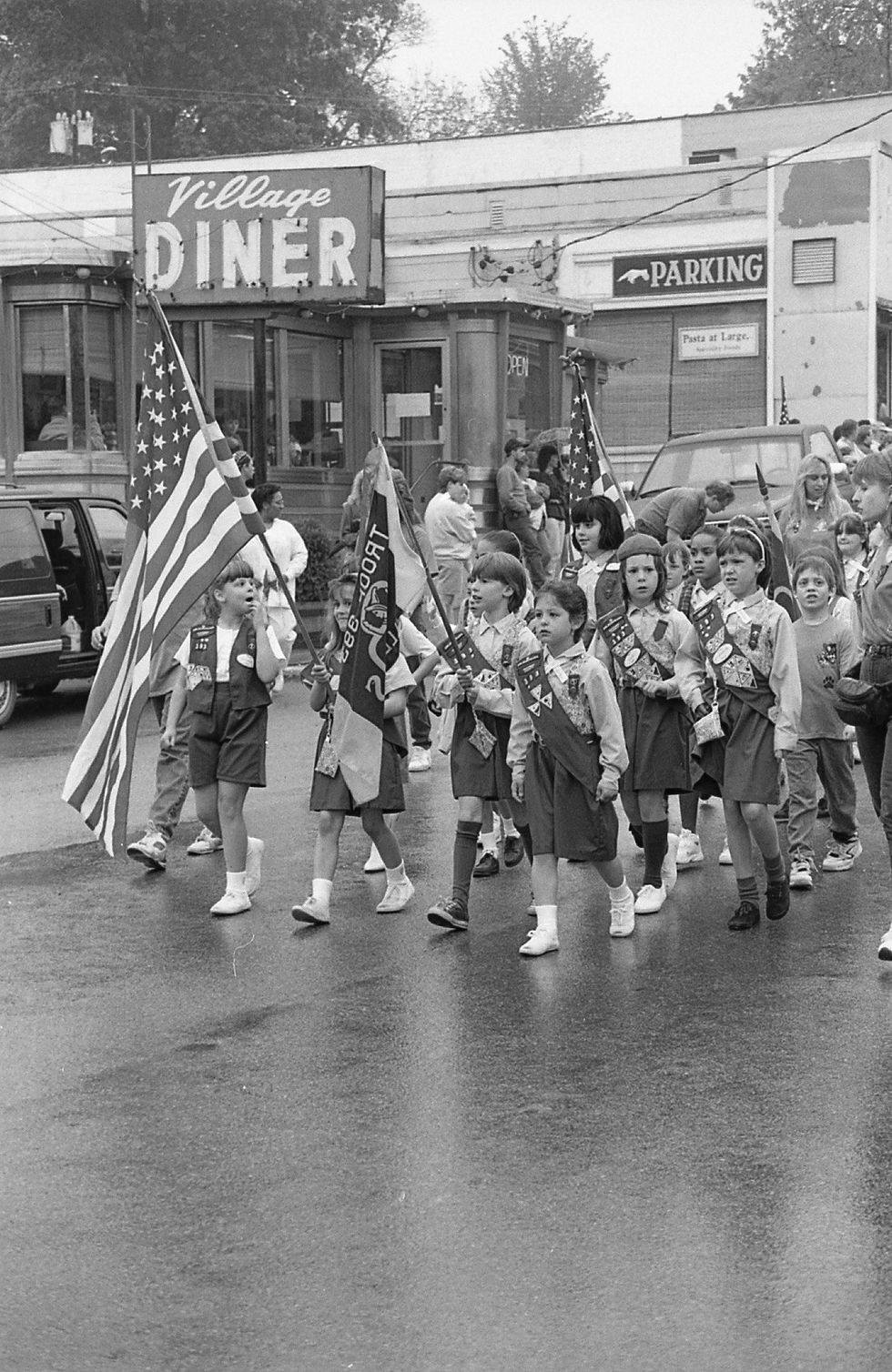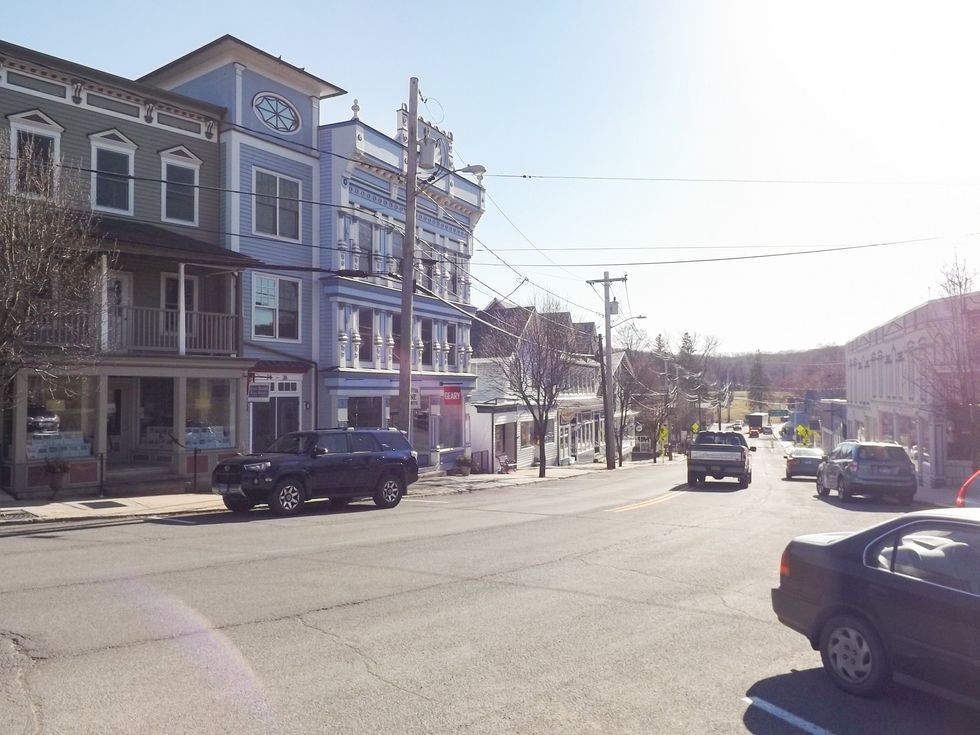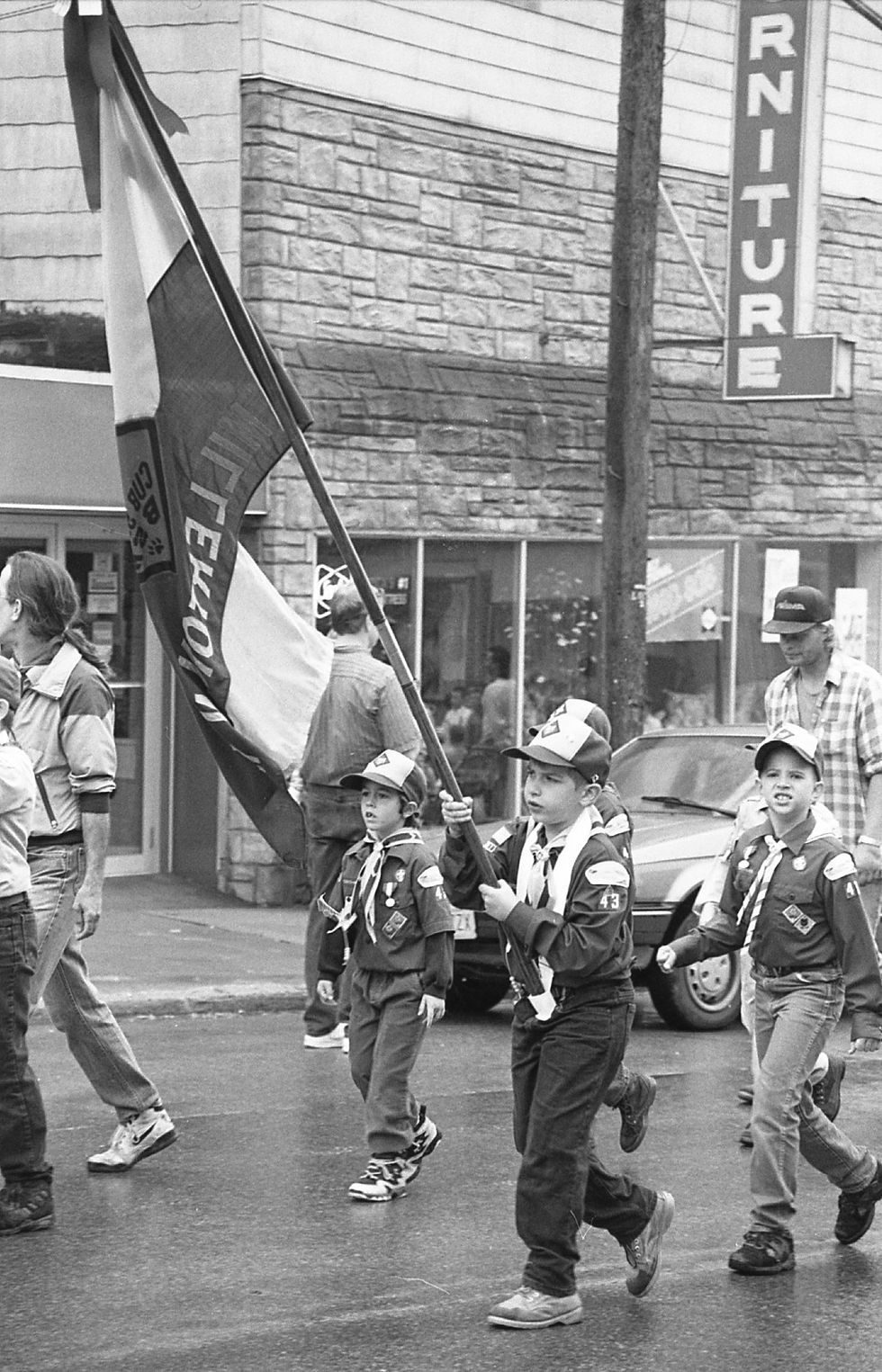
The Village of Millerton has changed greatly in the past 146 years since it was incorporated in 1875. Pictured here are various scenes from around Millerton, including a 1995 parade (in black and white). Photo by Kaitlin Lyle

With so many changes taking place in the world today, including in our local business communities, The Millerton News is taking a closer look at how the village of Millerton has changed in the years leading up to the present day. The paper will be running a multi-part series on the many changes that have taken place in the Millerton business district since it was first established in the late 1800s. This is the first part in that series.
Part I
MILLERTON — Despite all of the advances science has made in the millions of years since man has been on earth, no one has yet been able to figure out how to freeze time. Which explains why the world has witnessed Millerton evolve in the last nearly century and a half from what was a bustling local community that was mostly self-sufficient and centered around three railroads that brought the entire Tri-state region goods and services from major cities and outlying areas into a hip village that earned the title “Ten Coolest Small Towns in America” from Arthur Frommer’s Budget Travel magazine in 2007.
Those rave reviews have continued, frequently in The New York Times. The most recent was published in The Times on March 24; there was another large spread featuring Millerton on www.upstater.com, a guide about living, buying, renting and vacationing in upstate New York that just came out on April 20.
Who can blame them? Millerton has enviable amenities and resources, great shops, loads of antiques stores, restaurants and cafes; impressive yoga, pilates and wellness studios; a currently under-renovation Moviehouse and a beloved bookstore, both of which have entertained and enlightened generations in the region for decades and promise to do so for decades more; a business alliance that offers support to merchants that is becoming more and more useful; and two governments that have been working in concert with each other for nearly 150 years to get much-needed and important tasks done for the community — with repeated success and without any drama.
Village history and resilience
Incorporated in 1875 and named after the civil engineer who was working on the construction of the train lines being built in the town of North East, Sidney Miller, Millerton is at the crossroads of New York, Connecticut and Massachusetts, with routes 22 and 44 intersecting at the traffic light at the tip of Main Street. That’s where the commercial district begins, and where those who have witnessed the growth that has taken place in the village have seen the most dramatic changes.
Dick Hermans was born and raised in Milan, and now lives in Pine Plains, about 13 miles west of the village. Yet he is as much a part of the fabric of Millerton’s Main Street as anyone, as he started Oblong Books & Music with his then-business partner Holly Nelson 45 years ago. Oblong originally opened at 32 Main St., before ultimately settling at 26 Main St., where the beloved bookstore now stands. He spoke of the village’s strongest trait.
“Downtown Millerton is resilient, who comes in and who goes out, there’s always someone who wants to run a business here,” said Hermans. “It’s a small community that has businesses and it’s been that way since it started. It was that way when the railroad was here, which was how the goods got delivered here and supplies got delivered here; towns didn’t have those commercial centers… But we are resilient — there was always someone coming in here. No place stayed empty for any length of time, there is always quite a bit of turnover, even during the pandemic.”
A look back
Hermans reflected on how Millerton looked nearly five decades ago.
“It’s funny, because the anchors in town then were Saperstein’s and Terni’s, and Delson’s was still open across the street, and those were the real draws,” he remembered. “The bank is where the bank building is [at Gilded Moon Framing]; they don’t have that anymore. When we first moved here, The Moviehouse still had triple ‘X’ ratings, so that was kind of seedy. There were some bars here that were, seedy is probably a good word for it, but I don’t want to insult anyone; we had a reputation for being a rugged town when we got here.”
A look today
Millerton is a far cry from “rugged” today, with stores like Charlotte Taylor, a home and lifestyle store whose owner was once a buyer for Saks Fifth Avenue and Bloomingdale’s and a manager at Laura Ashley, or Westerlind, which sells gear and apparel for the outdoors in NYC as well as in Millerton, where it also has the Westerlind Pantry, where it “[aspires] to be the kind of bodega every good snob dreams about [selling] fresh bread, prepared foods, local produce, pantry staples, beer and cider,” according to its website.
Westerlind is at 41 Main St., the former Saperstein’s, which was the village’s iconic department store that had offered everything from shoe repair to Little League uniforms to tuxedo rentals for 70 years, until owner Lew Saperstein announced his retirement in 2017.
That was one of a number of monumental shifts from the business community’s past to its present that locals say will never be recaptured. Some are pleased with the changes and others not so much. More on that next week.
In the remainder of the series we will continue to examine how Millerton’s Main Street has evolved, and how the community feels about that evolution. Meanwhile, look for an article from North East Historical Society President Ed Downey about the village’s historic residential architecture on the next page. And be sure to support the businesses that advertise in this section.

Photo from The Millerton News Archives

Photo by Kaitlin Lyle

Photo from The Millerton News Archives
Left to right: Emi Night (Lead Educator), Luna Reynolds (Intern), Jill Winsby-Fein (Education Coordinator).
The Wassaic Art Project offers a free, weekly drop-in art class for kids aged K-12 and their families every Saturday from 12 to 5 p.m. The Art Nest, as it’s called, is a light, airy, welcoming space perched on the floor of the windy old mill building where weekly offerings in a variety of different media lead by professional artists offer children the chance for exploration and expression. Here, children of all ages and their families are invited to immerse themselves in the creative process while fostering community, igniting imaginations, and forging connections.
Emi Night began as the Lead Educator at The Art Nest in January 2024. She studied painting at Indiana University and songwriting at Goddard College in Vermont and is both a visual artist and the lead songwriter and singer in a band called Strawberry Runners.
Night sources her ideas for projects “from all over,” she said. “Sometimes we’ll pull ideas from artists in the shows [at The Wassaic Project] and if there’s something that seems like it would be fun for the kids, we’ll create a project around it.”
Night emphasized that the Art Nest is a drop-in opportunity as opposed to a drop-off class.
“Some families come in that are new in the area and don’t have a lot of parent friends,” Night said. “And they meet people here and develop a network. It’s a really cool space for that, and art is a great way to bring people together.”
Jill Winsby-Fein, Education Coordinator at The Wassaic Project also emphasized the community aspect of the offering. “We ask families to stay together, and that results in family art making that’s actually really special.”
Depending on the day, there can be up to 20 children and their families in the space. “Most days we have five or six kids at a time,” said Night.
The summer exhibition, “Tall Shadows in Short Order,” opens May 18 and the teachers expect an increase in attendance. The Wassaic Project has partnered with the Intern Project through the NECC (North East Community Center) and Luna Reynolds, a student at Webutuck Central School, is “our intern extraordinaire,” said Winsby-Fein.
“The projects I plan are geared toward kids ages four and up,” said Night, “but they are always adaptable to engage younger artists in sensory play and fine motor skill development. The average age range of attendees since I started working here in January has been three to 12. We do have materials and equipment more appropriate for teens like sewing and embroidery machines, jewelry and wire sculpture tools, button/pin-makers, and we’d love to have more teen artists working in the space.”
The program is funded through the Wassaic Project, which relies on grants, individual and donor funding, and artwork sales. Winsby-Fein is currently in the process of applying for various education grants to help fund the program.
“We have kids who walk from nearby and come every week,” she said. “A lot of the feedback I’ve gotten from families is about the community aspect.”
Families seeking to explore the world of art through The Art Nest are invited to drop by on Saturday afternoons. Visit www.wassaicproject.org for more information.
A detail from a fabric-crafted wall mural by Carlos Biernnay at the annual Kent Arts Association fiber arts show.
The Kent Arts Association, which last summer celebrated 100 years since its founding, unveiled its newest group show on Friday, May 11. Titled “Working the Angles,” the exhibition gathers the work of textile artists who have presented fiber-based quilts, landscapes, abstracts, and mural-sized illustrations. The most prominently displayed installation of fiber art takes up the majority of the association’s first floor on South Main Street.
Bridgeport-based artist Carlos Biernnay was born in Chile under the rule of the late military dictator Augusto Pinochet, but his large-scale work is imbued with fantasy instead of suffering. His mix of influences seems to include Wolfgang Amadeus Mozart’s popular German libretto “The Magic Flute” — specifically The Queen of the Night — as well as Lewis Carol’s “Alice’s Adventures in Wonderland,” The Tudor Court, tantalizing mermaids and exotic flora.
Upstairs, Litchfield-based fiber artist Karen Griska’s large quilts take inspiration from African tradition, although she has also worked in the styles of Amish quilting as well as the Black American tradition of Gee’s Bend, which began in an Alabama town of the same name.
For more on “Working the Angles” and Kent Art Association exhibition viewing hours go to www.kentart.org

If last month’s solar eclipse taught me anything, it’s that we all still love seeing cool stuff in the sky. I don’t think we realize how fast astronomical wonders are fading out of sight: studies show that our night skies grow about 10% brighter every year, and the number of visible stars plummets as a result. At this rate, someone born 18 years ago to a sky with 250 visible stars would now find only 100 remaining.
Vanishing stars may feel like just a poetic tragedy, but as I crouch over yet another dead Wood Thrush on my morning commute, the consequences of light pollution feel very real. Wincing, I snap a photo of the tawny feathers splayed around his broken neck on the asphalt.
It’s not the only such photo I’ll take this year. The building whose towering windows took this thrush’s life is infamous; like many other passersby, I pay close attention to the ground around such spots to record any victims. We upload our morbid photography to iNaturalist, an app usually reserved for more cheerful records and identifications of flora and fauna, where they automatically join several citizen science projects focused on bird-window collisions.
Why the macabre gallery? These collections provide concrete evidence of just how many birds windows kill. Ideally, that information encourages tactics to reduce casualties, like lobbying homeowners and institutions to add decals or screens to their glass.
Though such measures are critical for limiting window strikes during the day, we often overlook the damage our windows cause at night. Remarkably, most bird migration actually occurs by moonlight; if you stand under the stars and listen during migration — which began in earnest last week — an audible chorus of chirps and buzzes overhead indicates a sky full of birds.
Birds evolved to fly under the cover of darkness for many reasons. Nightly travel means they can spend the bright, bug-filled days gathering food. Darkness helps migrants avoid predators, and the lower turbulence and cooler temperatures of nighttime skies allows for more energetically efficient flights.
Though the specifics of nocturnal navigation are a longstanding ornithological mystery, that navigation is undoubtedly disrupted by the growing brightness of the night sky. Bright lights disorient the birds’ sense of direction and attract them towards the light sources themselves. In that state of confusion, nocturnal window strikes skyrocket.
In the U.S., one billion birds die each year by flying into windows. Distinct behavioral changes around brightly lit structures are the main cause of mortality: the usual conversation of nocturnal flight calls grows into a confused cacophony. Those that avoid collisions face different risks: the energy they waste investigating unfamiliar lights means they’ll have a harder time avoiding predators, catching enough food, and reaching their final destinations.
The harm caused by light pollution is not limited to birds. Even in rural areas, many nocturnal animals struggle to adapt to brightening nighttime environments: bats can’t fly efficiently, amphibians can’t reproduce normally, and insects can’t forage effectively.
Humans aren’t immune either. Brighter nights disrupt our sleep cycles — something I can personally attest to, as someone who grew up in Kent and now struggles nightly with the brightness of New Haven — and are associated with a slew of negative health effects. And though people widely associate more lights with greater safety, evidence of this is mixed.
Despite the repercussions, the reach and severity of light pollution keeps growing. Electricity usage in the U.S. is on the rise again; while much of that energy has more intensive uses, the U.S. Energy Information Administration estimates that 6% of residential and 17% of commercial energy is all for lighting.
As disheartened as I am by increasing energy usage and vanishing stars, by unnecessary lights glaring from empty sports fields or barren storage facilities, and by dead songbirds on my morning commute, there is a silver lining to this story. Fixing most pollution problems — microplastics, oil spills, atmospheric CO2 — requires complex, intractable solutions. Light pollution, on the other hand, is completely, immediately, effectively reversible.
This is a critical time of year to make that change. The transition from April to May brings spring rains, bursting tree buds, and a deluge of migrating birds: cheerful songs of Yellow Warblers, gleaming feathers of Scarlet Tanagers, playful flights of American Redstarts. You can watch these migrants gather above your home like a rising storm using BirdCast, Cornell Lab of Ornithology’s avian version of a weather radar.
The closer that storm comes, the more important it is to flip those light switches off. Simple steps, like limiting the use of aesthetic lighting, keeping the beams of necessary lights targeted, dim, and warmly colored, or curtaining bright windows, make all the difference to our birds. Participating in darkening the skies this spring will help keep these little travelers aloft — and maybe bring some stars back into view, too.
Alison Robey is a writer for the Kent Land Trust, a volunteer at the Sharon Audubon Center, and a third-year PhD candidate in Ecology & Evolutionary Biology at Yale University.